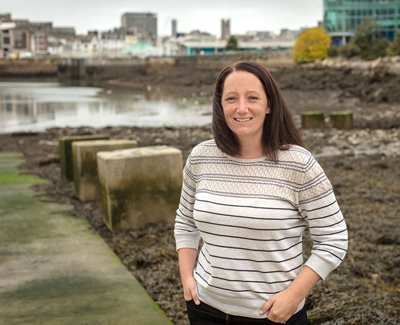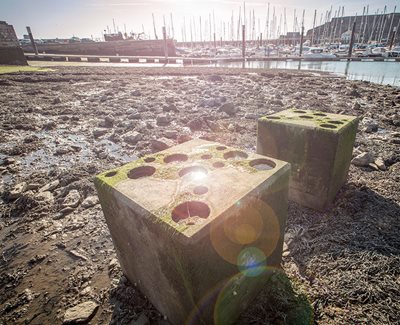Bio blocks
“Add complexity, and you give life a much better chance of thriving”

Looking a little like giant dice, the five concrete cubes on Teats Hill Beach, Plymouth, are an ongoing experiment in how to encourage marine life to inhabit man-made coastal environments. Each facet of these “Bio Blocks” contains different features – holes, overhangs and recesses of various depths. Everything from kelp to crabs and sea snails can try out a surface to see how they like it.
Plymouth University’s Dr Louise Firth has been involved with the project since its inception in 2018. “Expanding populations mean that human development is inevitable, and much of the world’s population lives on or near the coast,” she explains. “So new development often means replacing physically complex natural habitats, anything from a mangrove to a rocky shore, with hard, engineered structures. Unfortunately these are usually smooth, uncomplex, and leave little room for marine life.”
Using concrete’s unique ability to be moulded, Firth and her team have been attempting to recreate the complex shapes and surfaces that nature prefers. “Each Bio Block contains multiple habitats,” she says. “Overhangs provide shade, different-sized species occupy different-sized holes, and rockpool-like recesses offer shelter for creatures that need to keep wet when the tide is out.”
 Firth terms this approach “making space for nature” and says it can considerably soften the environmental impact of coastal development. “The principles we use here can make a big difference. Think about sea walls, rock armour defences and concrete groyns – these are all normally constructed from smooth, solid concrete or stone. Add complexity though, and you give life a much better chance of getting a foothold and even thriving.”
Firth terms this approach “making space for nature” and says it can considerably soften the environmental impact of coastal development. “The principles we use here can make a big difference. Think about sea walls, rock armour defences and concrete groyns – these are all normally constructed from smooth, solid concrete or stone. Add complexity though, and you give life a much better chance of getting a foothold and even thriving.”
The 1m3, 2.4 tonne Bio Blocks are made by Brixham-based Arc Marine, which specialises in concrete for marine applications, including its signature product: Reef Cubes. These are hollow cubes made from recycled aggregate and low-carbon concrete. They range in size from 150mm2 up to 2m2 12-tonne giants, and can be deployed as protection for underwater installations like cables, or to create offshore breakwaters. Advanced casting techniques create a rough surface that invites marine life to attach itself, while the interlocking hollow shapes provide reef-like structures where fish and crustacea can breed.
“This whole area was quite niche only a few years ago, but recently it has exploded,” says Firth. “There is now a lot of research going on, and companies all over the world have started producing concrete products that enable the built environment to work with nature, rather than against it.”
Words by Tony Whitehead
Photo University of Plymouth
Published in CQ Winter 2020